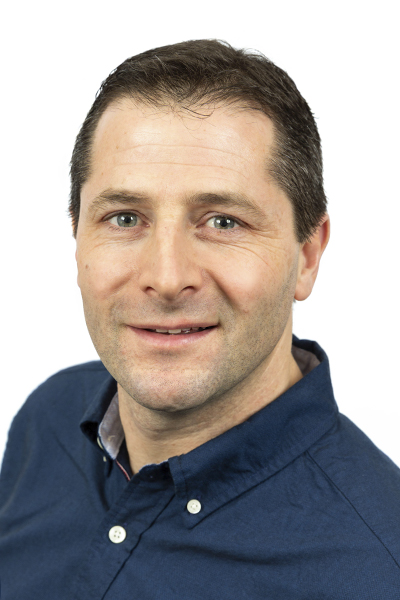|
Getting your Trinity Audio player ready...
|
Boston Scientific has been incredibly busy. In the midst of a pandemic, the company has remained focused on getting its life-changing medical devices to those who need them while also keeping its global team of more than 36,000 employees safe. And while the team focuses on driving innovation forward, there’s someone on the inside responsible for Boston Scientific’s own team.

Meet Noel Finnerty, Boston Scientific’s director of global real estate and facilities (GREFAC), who joined the company nearly 12 years ago. Finnerty was trained as a mechanical engineer at the University of Limerick in Ireland then explored the aeronautical and semiconductor industries with companies like Airbus and Intel, affording him the opportunity to work in Germany, Ireland, and the US. He found his way to facilities during his tenure with Intel which eventually prompted him to shift over to Boston Scientific as a facilities project manager.
Today, this role has a lot to do with shifting an entire workforce into a dynamic new environment, whether that’s at home, in the office, or in transit.
Finnerty spoke with American Builders Quarterly to share more about where his passions for sustainability and space utilization overlap with Boston Scientific’s own core values, and what the new workplace strategies will look like in a post-pandemic world.
What inspired you to transition from an engineering career to join Boston Scientific as its director of global real estate and facilities?
While I feel fortunate for the positive experiences that I’ve gained by working in a wide variety of fields, there’s a genuine attraction to working in the healthcare industry. Boston Scientific is a global medical technology leader. Our products reach over 30 million patients a year, so I feel like the work that we’re doing is impactful and meaningful. When people ask me what I do, it’s nice to be able to say that I work for a company that looks after people’s health.
At Boston Scientific, we have over 9 million square feet of real estate in 150-plus locations, both owned and leased, serving our manufacturing and commercial needs. Our GREFAC and Environmental Health and Safety teams work closely together to serve our 36,000 employees. My team looks after real estate, workplace strategy, facilities capital projects, and operational excellence. I am also the point of contact for facilities strategy in the regions outside of US.
What does a typical workday look like for you right now?
Every day is different. I really like switching between what are very different disciplines—everything from facilities capital planning and global real estate to energy management and workplace strategy. Personally, I love my role because of the diversity and working with people from a wide variety of backgrounds and regions. I’m based in Galway, Ireland, but because I’m on a global team, my work is wherever my laptop is. My day is usually structured by time zones—starting my day with calls in APAC [Asia Pacific], then transitioning to colleagues in EMEA [Europe, Middle East, and Africa] midday and ending my day with colleagues in the United States and LATAM [Latin America].
In what ways have you—or do you plan to—educate internal customers about the critical purpose and objective of your roles?
The key is to create and demonstrate value to the business. There are many facets to our approach to GREFAC that I feel are exemplar, but for me the ‘secret sauce’ lies in our partnerships, both internally and externally. In my experience you get the right balance by employing a small nimble team of top talent to be strategic subject-matter experts in each discipline and then form partnerships to enable the bandwidth to deliver on key projects and programs.

This approach ensures the integral Boston Scientific culture is in our DNA as a global service team while always keeping at the cutting edge of advancement in the various fields through our external partners. Our real estate workstream is mature and a good example of a well-established partnership with a world class agency. We have tracked our performance over the past decade through a singular metric, our Global Real Estate Efficiency, which is the company revenue divided by our total company square footage (both leased and owned). We have educated all our internal partners and stakeholders on our goal, and we’ve increased our real estate efficiency by 75 percent since 2012.
Boston Scientific maintains a strong commitment to sustainability, understanding that manufacturing great products and being environmentally conscious shouldn’t be mutually exclusive. How have your personal values and PhD studies driven the company toward carbon neutrality?
We challenge ourselves every day to deliver on the promises we’ve made to our customers, the patients we serve together, and our employees, all while caring for the planet. Our pledge to be good corporate citizens and stewards of the environment has pushed us to lead in our industry and always strive to improve.
My first opportunity to make a significant impact in this area came when I joined the GREFAC team. We started a community of practice with all our key sites and quantified our energy consumption and associated CO2 emissions. In a research partnership with the National University of Ireland, Galway (NUIG), we developed our centralized “Global Energy Management System,” which we refer to as GEMS, and I was afforded the opportunity to complete my PhD on this very subject I was so passionate about. The symbiotic relationship between my work and studies drove an exemplar academic–industrial partnership, with the academic research rigor guiding the industrial application and the associated outcomes informing the research further.
The GEMS research reached its pinnacle in September 2017 when at Climate Week in New York we announced our commitment to Carbon Neutrality for our manufacturing sites and key distribution centers by 2030. None of this would have been possible without the unyielding support we got from Boston Scientific leadership, both our executive committee and board of directors. A strength of GEMS is its simplicity, and it was successful in the connecting the “boiler house to the boardroom,” connecting the practitioners with the decision makers.
How does this commitment to sustainability impact your global real estate strategy?
We track our sustainability commitment through six GEMS key performance indicators and report these annually in our combined financial and sustainability performance report. One of these KPIs is “Green Real Estate,” and it is the percentage of Boston Scientific’s real estate that is independently certified for energy efficiency by industry-leading programs such as LEED or ISO50001. It has gone from 27 percent in 2015 to 45 percent by 2020; that’s over 4 million square feet of our portfolio and growing. I would stress that in order to maximize the sustainability impact our real estate strategy also needs to work in symphony with our global workplace strategy.
Boston Scientific is on target to source or generate 100 percent of our electricity from renewable energy sources by 2024. And by 2027, we expect that 90 percent of all energy, including electricity and natural gas, will be renewable at all our facilities putting us on track to meet our 2030 commitment.
COVID-19 has understandably played a major role in the transformation of your workplace strategy as well. Can you share some details around the global office redesign planning? Will it be aligned across all 150-plus locations, or will they look differently individually?
Our priority since the start of the pandemic has been to ensure we continued to serve our customers whilst maintaining a safe working environment for all our employees, both onsite and remotely. We launched a strategy to cover our immediate response to the pandemic detailing the infrastructure and protocols to allow our sites to reopen for appropriate numbers when needed.
We then turned our attention to the medium- and long-term impacts. With approximately 4 million square feet of administration space, it is critical to ensure our approach is aligned across all our locations. The cornerstone of the Boston Scientific workplace strategy is our Global Design Guidelines (GDG); this is essentially a playbook with all our specifications and best practices to drive consistency in the delivery of our office upgrade projects regardless of location across the world. It is a technical document [shared with] the workplace strategy practitioners in each Boston Scientific location . . . it has continuously evolved with lessons learned and industry advancements since version 1.0 in 2011.

We also deployed a Global Employee Survey. Having the “voice of the customer” as a key input into any future design is fundamental and the survey confirmed that our employee base had a desire for a more agile future work environment—taking the best of what can be accomplished more effectively in a remote setting, while maintaining the ability to collaborate face-to-face on site. This will drive the need for change to how we structure our work modes to best serve our employees, to our future office design to create more collaborative type spaces, and to how we support our employees in remote settings.
Based on the results of the survey, how did you approach the change management and develop some of the concepts in the new way of working?
We quickly learned that significant changes to people’s workplace experience is much broader than facilities and that change management and effective communications were paramount. In partnership with HR, we formed a global connected workplace strategy core team composed of cross functional leaders from HR, communications, IT, and facilities.
Right now, we are ensuring all our employees have the right equipment to effectively and safely complete their work in a remote setting, and we continue to balance our employee and business needs to develop all aspects of our future agile workplace experience, such as employee work modes (onsite, hybrid, and remote). Our team is developing a concept which will strive to combine the advantages of work-at-home with the advantages of office work and create a “physical” workplace environment that propels the business forward.
Increased shared and collaboration spaces, appropriate equipment, and associated etiquette to cater for hybrid and remote employees when on site will be key building blocks. In addition, it will ensure our facilities are prepared for similar pandemic threats in the future. We’ll also be taking shared learnings and best practices on the COVID response from around our global locations and from the broader industry and distilling them into GDG v5.0.
How else do you see this measured workplace strategy benefiting Boston Scientific in the future?
It can result into a reduced real estate portfolio improving the real estate efficiency and associated capital for building office space. Sustainability can be the silent beneficiary from the new way of working. Practices that will result in less “physical” office space and significant reductions in travel, both from a workplace commuting perspective and business travel, will have positive implications for the environment and climate change. Boston Scientific teams have embraced the challenge, and we are inspired by the opportunity to improve the health of patients around the world while also making measurable contributions to the world we share.


